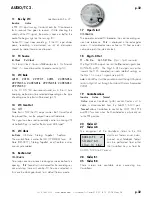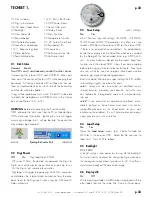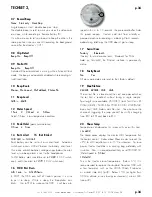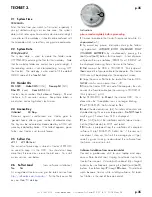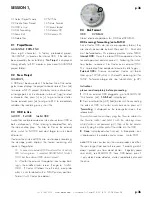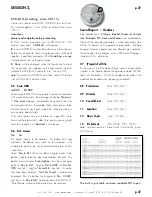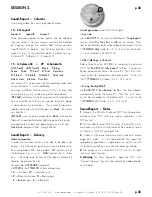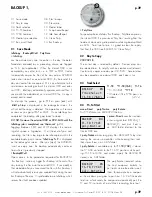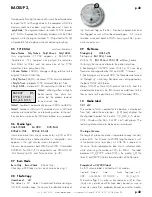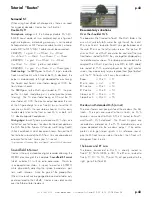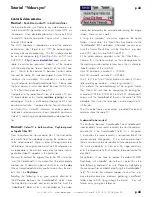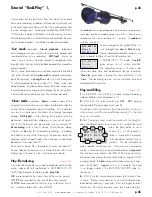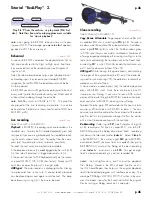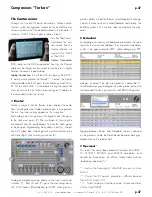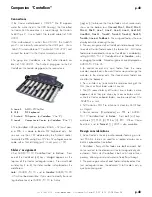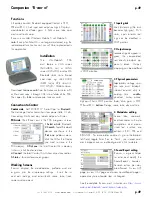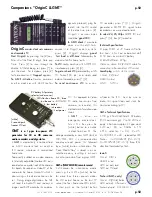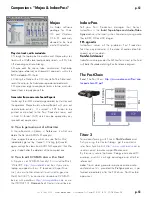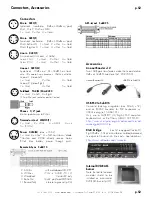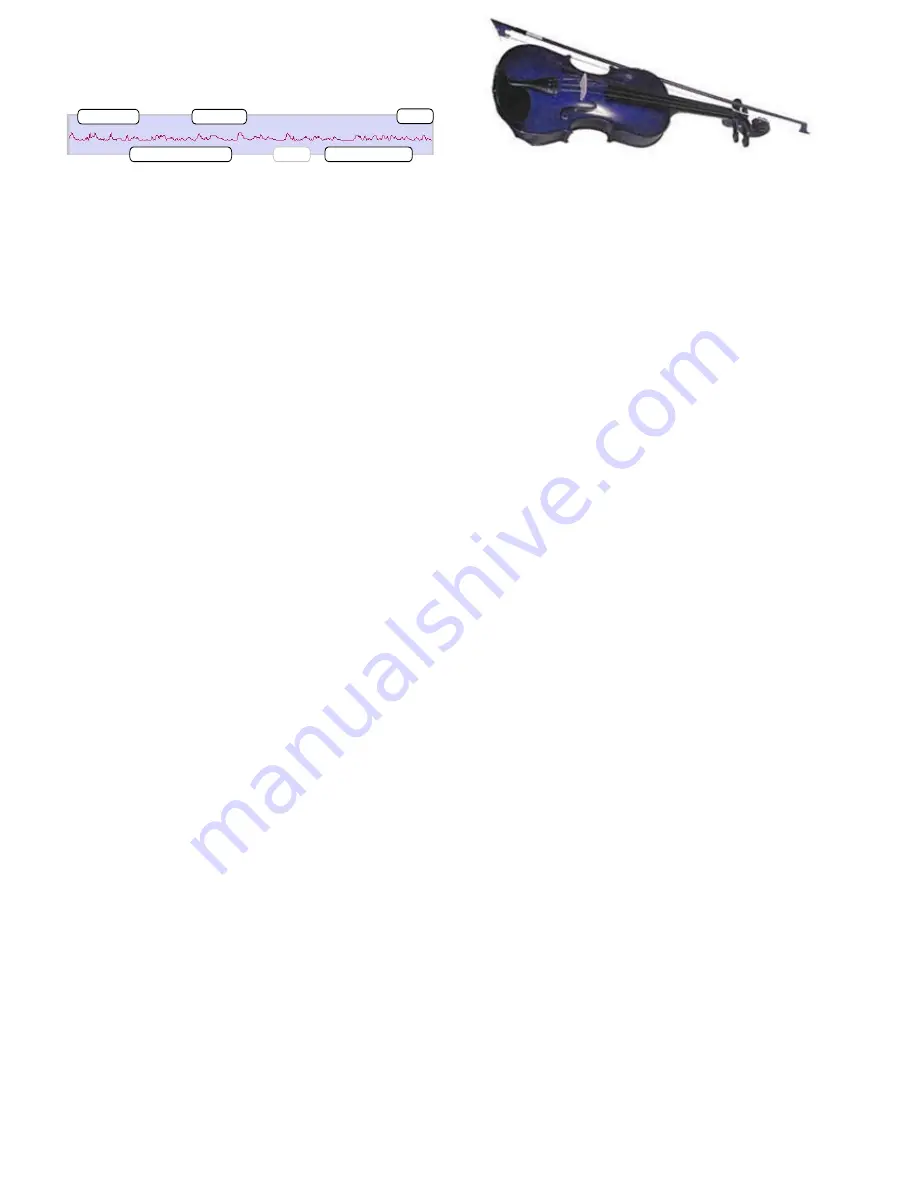
+33 4 7642 9550
www.aaton.com
User manual for Cantar-X1 & X2 v2.15 2008 March 28
p.46
p.46
Tutorial "Rec&Play" 2.
note:
when going to BLUE-PLAY, take your time while pass-
ing over STOP! if the message '
you were too fast
' appears,
go back to STOP for one second.
Rehearsal
Cantar-X1 & X2
As soon as BLUE-TEST is activated, the playback tracks Tp1 to
Tp6 are internally sent to the Digi1 to Digi6 inputs; from there
they are routed (or not) the standard way (see '
Examples of
in-grids
' p.18).
Adjust the relative levels between digi inputs (playback tracks)
and analog inputs, then rehearse your intended BLUE-REC
navigation; the last BLUE-TEST selected play-card will be the
first to be played.
In BLUE-TEST you can swiftly go from one play-card to the next,
a very useful tip to let the film-director verify your 'hilited' parts of
a take without scrubbing through the entire file.
note:
Rec&Play works at 48kHz (±0.1%). The play-files
are played at the 'Live' recording sample rate, this can be
quite useful on filmed music shows transferred to NTSC (see
BLUE-REC p.23).
Live recording
Cantar-X2 only
Select 'Live (all)' in
BLUE-BRWS.21
Playback
In BLUE-REC, the analog inputs are recorded in the
standard way. To play the first selected play-card, press [ok]
(or [space] if you are using a keyboard). To stop before reach-
ing the card's cue-out, press [ok]. To replay from the cue-in,
press [ok]. To pause, press [esc], to resume, press [esc].
To reach the next card, two methods are available,
• the bare bone: browse the '
view'
tagged play-files with [shift]
[>], then select the desired '
*
'
tagged play-card with [>],
• the easiest: connect a PS2 keyboard and type the succes-
sive card IDs (B12, F45, A08), then [enter]. Tarkan (p.47)
can help you open the play-list in the right order.
ADR type1
The actor records his dialog right after listening
to a play-card from its cue-in to its cue-out (each play-card
can be played again and again to satisfaction). The bare-
bone browsing (using [>]) is the one to be used.
Clone recording
Cantar-X2 only
Select 'Clone (x)' in
BLUE-BRWS.21
Copy, Remix & Translate
To get copies of archive files with
an updated iXML chunk, select in-grid
RPA
(p.18). To redo a
mixdown under the control of the on-board mixer or CantaRem,
select in-grid
RPM
(p.18) in which the Xa Xb mixdown goes
to T7 T8; note that you can add a simultaneous translation of
a foreign language dialog by either routing two Digi-ins to the
same track and sending the translation mic to the 'freed' track,
or selecting
RR7
in which 'Mic5 Xb' records the translator's mic
on T7 and the mono-mix (without T7) on T8.
ADR type2
While listening to the guide track(s), and watching
the images of the original shoot (the LTC-out of the master be-
ing used to sync a chasing VTR), the performers re-record their
dialog on a new set of tracks.
In clone mode, no need to press [ok], the selected play-card
plays at BLUE-REC start. Since there can be only one TC
stamp per new filetag, if you want to remix/ADR a short
portion of the master file, go to BLUE-PLAY, create a short play-
card and return to BLUE-REC, opening a new filetag.
To abort the take, go to PPR and delete the file (see
Last take
erasure,
p.20) and return to BLUE-REC to redo it. You can
continue to record live audio after the end point of the master
play-files but this 'tail' generates a longer file than the master
at the risk of timecode overlap with the next take.
Re-Recording
Under in-grid
RR1
(see
Examples of In-grids
p.18), record your first track in normal REC. Go to BLUE-
BRWS.04 and put the filetag of your best 'track1' recording
(not always the latest one) under '
Index A
’. Select '
Clone A
'
in BLUE-BRWS.21, then under in-grid
RR2
go to BLUE-REC
and record 'track2' (as many times as needed); then go to
BLUE-BRWS.04, and put the filetag of the best recording
under '
Index A
’... and so on, up to
RR8.
You get an eight
track incremental recording in your last recorded file.
note1:
the Linking-Trios carry two TCs and the playback
file's filetag. Stored in the iXML of each live file, and in
the CSV Sound-Report, they help sync the original playback
track(s) to the edited program with sub-frame accuracy. The
message
'PB filetags: AB1234, XY9753'
written in the com-
ment line makes it easy for the final mixer to find the original
files by running a filetag search on his computer.
E 01
E 15
E 04
E 34
*
E 08
E 45
Play-file 'E' from the archives, six play-cards (E34 hid-
den). Note their free and overlaping placement, suitable
for 'classic playback'

